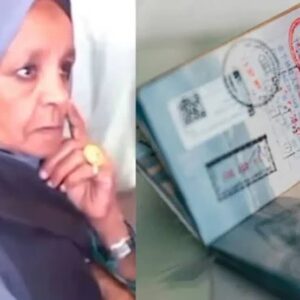Skip to content
Here’s what seems to be going on — and why the story of a “woman from Torenza” landing in the U.S. has caught fire, even while being demonstrably false.

The Viral Clip: What It Claims
Over the past week, a video has circulated widely (on TikTok, X, Instagram) showing a well‑dressed woman at JFK Airport allegedly arriving from Tokyo.
In it, she presents a passport from a country called Torenza — which, according to the narration, does not exist in any known atlas, registry or database. (@mathrubhumi)
The video builds dramatic tension by showing immigration officials perplexed, the woman maintaining composure, and the purported passport itself featuring biometric chips, holograms, and stamps — some even claimed to be from non‑existent nations. (Gulf News).

At one point, the narration says that when told “Torenza is not real,” she allegedly “froze” and whispered, “Then this isn’t my world.” (@mathrubhumi)
Unsurprisingly, in social media comment threads, people speculated wildly: time travel, parallel dimensions, conspiracy coverups.
The video was shared as “shocking breaking news,” often without source attribution. (LatestLY)
The Reality: A Fabricated Hoax
As enticing as the story is, multiple fact‑checking organizations have concluded this is not true — the video is a likely AI / digital fabrication. (Lead Stories) Here are the key reasons:
-
No credible confirmation from authorities
Neither JFK Airport, U.S.
-
Customs and Border Protection, nor other official agencies have acknowledged any instance of someone arriving with a “Torenza passport.” (www.ndtv.com)
-
If such a bizarre incident had occurred, it would be extraordinary news — yet no mainstream news outlets (beyond the viral video) have reported it. (www.ndtv.com)

Reuse of old footage + AI overlays
LeadStories, in particular, traced portions of the visual background to a U.S. cable show “Airline” from the mid-2000s, unrelated to JFK or a passport drama. The creators appear to have overlaid a voiceover, graphics, and fictional narrative atop reused imagery. (Lead Stories)
-
AI / synthetic signals in visuals and audio
The video shows inconsistencies common to AI or composite editing: unnatural lighting/reflection behavior on the passport, overly smooth motion or edges, and audio voiceover elements hinting at voice cloning or text-to-speech manipulation. (Lead Stories)
-
Some clips even vary between “Torenza,” “Terenza,” or “Torkezza” in different versions — a telltale sign of synthetic remixing. (Lead Stories)
Echoes of old urban legends
The narrative of a traveler arriving with a passport from a country that doesn’t exist is not new.
It’s heavily reminiscent of the “Man from Taured” legend of 1954 (Tokyo’s Haneda Airport) — a frequently cited story of a man claiming to be from “Taured” who vanished under mysterious circumstances. (@mathrubhumi)
Also, a real-life 1959 case involved John Zegrus, who used forged passports from fictitious nations such as “Tuarid.” (www.ndtv.com)
Given all these red flags, the claim that a real woman recently landed in the U.S. with a “Torenza” passport is unsupported by evidence and almost certainly false. (Lead Stories)
Why the Hoax Resonates (and Spreads)
-
The allure of mystery and the unknown
Stories of secret countries, hidden dimensions, or strangers slipping through reality’s cracks captivate imaginations. People want to believe there’s more beneath the surface.
-
The video taps exactly into that vibe — which ensures high engagement.
-
AI tools make it easier
With modern generative AI, it’s simpler than ever to overlay audio, generate realistic passports, or composite scenes that look superficially believable.
-
The technical barrier for producing near‑convincing viral hoaxes is lower than before.
-
Viral mechanics push sensational content
Platforms are optimized to amplify bold, curious, or sensational content quickly.
-
Before fact-checkers can respond, the content spreads wildly. Many viewers never pause to ask: “Is this verified?”
-
Cultural echoes and meme potential
Because the “Man from Taured” myth has floated around for decades, people are already primed to connect strange passport stories with cosmic or conspiratorial interpretations. This gives the “Torenza passport” meme staying power.
What Lessons to Draw
-
Always seek verification
Even if a video looks “polished” or “professional,” it doesn’t guarantee authenticity. Especially with border stories, check for independent confirmation from credible news or official agencies.
-
Be skeptical of dramatic narratives
Claims that seem engineered for shock value or to provoke existential questions (parallel worlds, “this isn’t my world”) are red flags.
-
Understand how AI augments misinformation
We’re entering an era where fake visuals, audio, and documents can be fused seamlessly.
Critical thinking — and media literacy — is more essential than ever.
-
Urban legends evolve with technology
The “Torenza passport” is not a new myth — it’s a modern retelling of older tales, dressed in AI-era costumes. Myths don’t die; they adapt.
In short: No, a woman from “Torenza” didn’t really land in the U.S.
It’s a digital-age hoax — a viral tale assembled with AI tools, built around an appealing mystery, and amplified by the very nature of social media. The excitement is real; the event is not.






